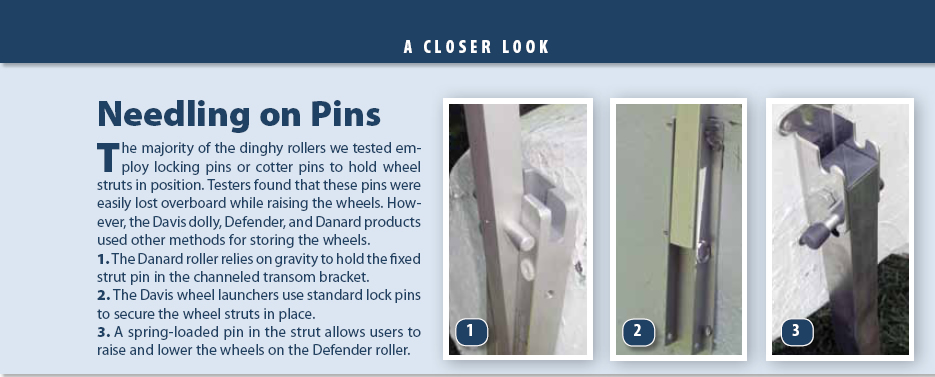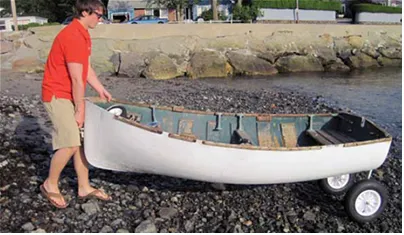
Photos by David Liscio
388
Getting your dinghy to the dock, across a beach, or down a boat ramp can be a real back-breaker, unless you have some mechanical advantage. Several manufacturers offer wheeled devices to keep you out of the chiropractor’s office and help ensure you’ll be able to stand erect in old age.
Choosing the most suitable model depends on where you intend to launch the dinghy. If your dinghy is stored in a rack at a marina, you may only need a rolling system with a quick clamp-on bracket and solid rubber wheels no larger in diameter than those on a standard push lawnmower. After all, molded plastic wheels work fine on concrete or asphalt. But if getting to the water means crossing over a soft, sandy beach or moderately rocky terrain, then dinghy rollers fitted with inflatable tires will perform better.
While some dinghy wheels are fitted with inflatable tires ranging up to 16 inches in diameter, the largest of these can prove unwieldy in heavy wind and can be problematic to stow. Sticking straight up from the transom of your dinghy, these big wheels can act like sails and create unwanted windage as you row or motor the dink.
Most dinghy wheel setups we tested require drilling and installation on the transom with nuts, bolts, and washers. Tools are required, including a drill, assorted wrenches, a ratcheted socket set, small T-square, and a tape measure. One model we tested clamps to the transom with twin screw-down fittings—a convenient configuration, but it requires flipping the dinghy over upon reaching the water’s edge. Another model, a dolly with bunks, relies on webbing and plastic snap buckles to secure the dinghy.
Simplicity of design, quality of materials, and overall workmanship also should be taken into consideration as significant factors when selecting a set of dinghy wheels. Cheaply made, zinc-plated metals simply cannot hold up to saltwater like stainless steel can.
Some dinghy rollers require the user to insert multiple cotter, clevis, or lock pins when changing the position of the wheel struts from a wheels-down to a wheels-up position, and vice versa. Still another avoided the use of these pins altogether, depending instead on gravity and buoyancy to hold the wheel struts snuggly in the transom brackets.
What We Tested
There are plenty of dinghy rollers and dollies on the market, some with wheels that are designed to temporarily clamp on during service and others that are permanently mounted. Construction materials range from chrome-plated zinc to marine-grade aluminum to stainless steel. Most can be used on rigid-inflatable boats (RIBs) or hard dinghies. Our test field—seven products from Davis Instruments, Garelick, Newport Vessels, Defender Industries, and Danard Marine—represented a cross-section of the various types that are available.
We tested three models from Davis: one dolly and two sets of inflatable launching wheels. The California-based manufacturer is best known for its line of boating accessories, particularly its wind vanes, and currently produces a line of dinghy wheels in varying sizes.
From the Minnesota-based aftermarket marine accessories maker Garelick, we tested a molded-plastic set of launching wheels. Testers also evaluated inflatable launching wheels from RIB-maker Newport Vessels, discount marine outfitter Defender Industries, and Danard Marine, a California-based marine products maker and distributor.
The test products ranged in price from $65 to nearly $300 and are designed to tote 250 to 350 pounds on a hard surface.
We tested each dinghy roller on three different terrains: flat concrete, a rocky shore, and a soft, sandy beach. Testers also considered ease of use and ease of installation. For more on the test criteria, see “How We Tested” on page 23.
Davis Wheel-a-Weigh Dolly
The Davis Wheel-a-Weigh Small Boat Dolly (extra capacity model) is big and cumbersome, and it clearly could be a problem to stow. It was one of two test products that didn’t require installation, which means it can be used to launch multiple boats. It literally snaps together using stainless-steel lock pins through the axle. No tools are needed.
Designed for rowing shells, kayaks, dinghies, and various small boats, the dolly has a weight capacity of 250 pounds on a hard surface and 150 pounds on soft sand. Made of aluminum and plastic, the dolly keeps the dinghy in place with webbing and quick-release buckles. The fully pneumatic, 16-inch-diameter inflatable tires are mounted on injection-molded rims.
While the dolly performed admirably on all surfaces, we found it frustrating to try to position the dinghy on the adjustable bunks. The dolly kept rolling forward and slipping away. It took two testers to get the dinghy on the dolly, but once it was aboard, the dolly could handle any terrain.
The manufacturer has fitted the dolly with a foot rod, similar to a bike’s kick stand, to keep it upright, and presumably to keep it from rolling away. The dinghy dolly is too big to take along in the dinghy, which means you must return to the launch site to stow it and must retrieve it again when you haul out.
One of the more expensive products tested, the $233 dolly is designed to handle loads up to 250 pounds on a hard surface and comes with a one-year warranty.
Bottom line: The Davis small-boat dolly is easy to assemble and performed well on all terrains, but its size and design limit it to near-ramp and near-rack use. It’s worth considering if you have multiple boats to launch (i.e. Lasers, a kayak and a dinghy, etc.).
Davis Launching Wheels
We tested two of Davis’ Wheel-a-Weigh Launching Wheels products: model 1461, a compact system with a straight-forward design; and model 1481, an extra-capacity version of the 1461.
Model 1461: The 1461’s assembly must be bolted to the dinghy transom. It requires a drill, wrenches, hammer, measuring tape, and a small T-square. Installers must drill eight holes in the transom to mount the two anodized-aluminum brackets, and each is held in place with four nuts and stainless bolts. A hammer is needed to tap the lock washer cap onto the axle.
The four 8-inch-diameter rubber tires are excellent for flat or slightly irregular surfaces, but in testing, they tended to get hung up in soft sand and on rocky shores. Two wheels are mounted about two inches apart at the end of each anodized-aluminum strut. During testing, small rocks jammed between the twin rubber tires, which also tended to sink into soft sand.
The system uses stainless lock pins to secure the wheel struts to the aluminum shafts bolted to the transom. The lock pins were easy to use but repeatedly fell out during testing, leaving testers searching for them in the sand and between rocks. We’d recommend tethering the pins to the launcher with thin line to be sure they don’t get lost.
The Wheel-a-Weigh Launching Wheels has a 250-pound weight capacity on hard surfaces and 100 pounds on soft sand. The $128 price tag comes with a one-year warranty.
Model 1481: At first glance, the extra-capacity Davis Wheel-a-Weigh Launching Wheels seems too large to be practical. Like the Davis dolly, it features pneumatic, 16-inch inflatable tires mounted on injection-molded rims. It is designed for launching larger, heavier dinghies and small boats. It has the second-highest carrying capacity of the test products: 300 pounds on hard surfaces and 200 pounds on soft sand. Only the Danard wheels claim to carry more weight.
Tools—a drill, wrenches, measuring tape and small T-square—are required to mount the anodized-aluminum brackets to the dinghy transom. Once mounted, the brackets accommodate anodized-aluminum wheel struts. The brackets for the Davis 1461 and 1481 are the same, which allows users to attach either the twin plastic tires or the larger, inflatable tires.
The system conquered all three test surfaces with no problem, and testers attributed this to its relatively large wheels and soft tires. Testers also noted that in the up position, the large wheels tended to catch the wind while we were underway, pushing our dinghy off course as we rowed.
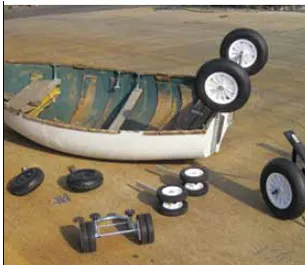
305
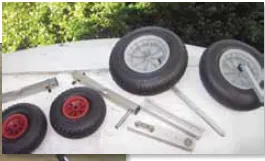
Once in the water, flipping the wheels from the down position to the up position was challenging because of their size and weight. Keeping the wheels in the upright position required removing the lock pins from holes in the strut nearest the water surface and reinserting them higher along the strut after the wheel position was changed. The lock pins tended to wiggle and come loose with only slight vibration.
Bottom line: Priced at $200, the 1481 extra capacity model tackled all terrains well and is made of quality materials. It gets PS’s Recommendation.
Garelick Eez-In
We were initially excited by the Garelick Eez-In (71050) because it appeared to be sturdy, compact, simply designed, easy to mount, and easy to stow. With a pair of knob-handled fittings designed to attach the dinghy wheels to the boat transom, there’s no assembly required for setup.
The Eez-In has four 7-inch, molded plastic wheels—two each butted together at the axle ends. The frame is made of zinc-plated steel and has a carrying capacity of 250 pounds on a hard surface. It is designed for moving dinghies and small boats and is easily attached to the hard transom of an upside-down inflatable boat.
The upside-down carrying method was one of this model’s drawbacks, in our opinion. Unlike most of the other test models—which attach and roll the dinghy right-side up—the Garelick requires the user to roll the dinghy keel-side up to the water’s edge, then flip it over onto its keel before launching. When we twice attempted to do this, the screwed-down fitting loosened, which then cocked the dinghy roller at an unwanted angle. It required both strength and agility to flip the 130-pound dinghy into the upright position. In doing so, the dinghy hull was scratched on the concrete boat launch ramp.
During testing, the Garelick dinghy roller performed without a hitch on the flat surface, but became stuck on the rocks, and field testers were forced to carry the dinghy up the shore. On the beach, it sank to its axle in the soft sand.
On the positive side, it’s portable, so it can easily be tossed into the dinghy and carried.
The least expensive product tested, the Garelick Eez-In can be purchased for as little as $64 online.
Bottom line: The Eez-In is easy on the wallet, but hard to use on bumpy terrain.
Newport Vessels
The Newport Vessels Launching Wheels system features stainless-steel, transom-mounted brackets and stainless wheel struts. Mounting the model to the dinghy transom requires a drill, wrenches, measuring tape, and a small T-square. Like the Davis models, the brackets and struts are designed so that the dinghy can be wheeled upright to the water. Once aboard, a series of pins can be removed and the wheels lifted from the water until locked in the upright, or skyward, position.
Each wheel strut attaches to the transom bracket with two clevis pins held in place by a ring on one end and a cotter pin with ring on the other. To adjust the struts, the cotter pin is removed, as is the clevis pin. When the wheel is pulled from the water, the pins are re-inserted higher along the strut to keep the strut in place. The short axle shaft on each wheel attaches to the strut with a washer and cotter pin.
Like the Davis designs, it is easy to lose the pins. Removing and reinserting them could prove problematic in a choppy sea or on a cold day with numb or gloved fingers. To lessen the possibility that the struts will be lost overboard while switching pins, Newport Vessels supplies a thin strip of metal with a series of holes, which is used to secure the strut to the transom bracket at all times.
The model’s 10-inch tube-style tires are rugged, and their size and construction are adequate for flat surfaces and rocky shorelines. During testing, however, the wheels tended to sink into soft sand and were snared by the rocks.
The $150 Newport launching wheels, manufactured in China, are designed to handle 300 pounds on a hard surface.
Bottom line: The Newport Vessels dinghy roller was a good performer but not a top performer.
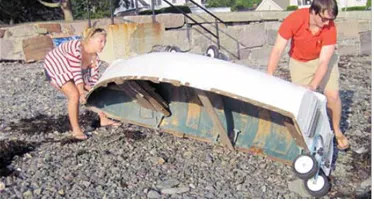
374
Defender Launching Wheels
The Defender Industries Launching Wheels are similar to the Newport Vessels model, but feature higher-quality components. Where the Newport Vessels model has parts made in China, the Defender launching wheels boast Italian-made stainless-steel wheel struts and transom brackets. According to the manufacturer, stainless is more compact and rugged than its aluminum or zinc-coated counterparts.
The 10.25-inch inflatable tires are rated for a 220-pound load, and like the Newport Vessels model, the launching wheels are designed for dinghies or small boats. Defender also markets a large set of launching wheels (model 7085), with 14.5-inch wheels, but it’s more commonly sold to commercial users.
Another special feature sets the Defender model apart from the competition: a spring-loaded lock pin fitted inside the wheel strut allows repositioning the strut from in the water to upright, eliminating the need for cotter or clevis pins. Although the pin and spring are stainless, we still recommend keeping an eye on them for corrosion over the long haul. However, according to Defender, there have been no reported failures of the spring in 10 years of manufacturing the wheels.
The Defender product was an adequate performer overall, but it struggled in the rocky shore and sand tests. Based on our tests, Defender’s larger-wheeled model )7085) would have performed better on these terrains.
Bottom line: Costing $190, the Defender wheels are well-made and sport innovative design features.
Danard Launching Wheels
A glance at the components tells plenty about the top quality of the Danard Marine Launching Wheels. Company owner Gordon Heck has created the Rolls Royce of launching wheels, in our opinion, using precision-machined aluminum for the transom brackets and wheel struts. He also has found a way to raise and lower the wheels without need for cotter, clevis, or lock pins. Heck designed a system that relies on gravity and buoyancy to hold the struts in place inside the channeled transom brackets.
The company also uses Butyl tire tubes rather than less-expensive natural rubber, and a brass, angled air fill to reduce wear to the stem. Danard Marine makes the DW-1 model for dinghies and small boats and the DW-2 specifically for newer RIBs. The DW-2 offers several mounting options and incorporates a padeye into the mounting of the base to facilitate a lifting sling. According to Heck, many customers have tested the limits of his products by mounting them on larger inflatables, 13 to 18 feet. The company is developing a larger set of launching wheels for boats in that size range.
We tested the DW-1, the only test product that earned across-the-board Excellent ratings. The Danard DW-1 was the most expensive dinghy-launching system we tested, but not by much, and it is the only one that comes with a lifetime warranty.
Bottom line: The DW-1 was the hands-down Best Choice among the dinghy launchers we evaluated. Its superior construction quality, ease of use (no pins to worry about), innovation, and lifetime warranty put it at the head of the class.
Conclusions
Selecting the appropriate launching wheels depends on the size and weight of your dinghy or small boat, where you intend to use it, and the surface that will most commonly be crossed in getting the dinghy to the water. Not every set of launching wheels can handle soft sand or rocky shores, but those that proved capable during our tests have large-diameter inflatable tires. If you have to cross a soft beach, then the larger wheels are a must. If you are on concrete or asphalt most of the time, launching wheels with little more than push-lawnmower-size, rubber tires are adequate.
We also found that models requiring no cotter or clevis pins were easier to use and eliminated concern about losing the small bits overboard. However, designs with permanently mounted transom fittings, when used on a boat’s tender, have the potential of scratching the mother ship’s paint job when the dinghy wanders around with the current.
Danard Marine’s DW-1 launching wheels system was our Best Choice because it can handle just about any kind of terrain, is made of high-quality materials, does not require clevis or cotter pins, and depends on gravity and buoyancy to snug the wheel struts to the transom brackets.
The Defender 7085C performed well on flat surfaces but struggled a bit on rocks and sand. However, its design eliminates the need for clevis or cotter pins, instead using a spring-loaded lock pin on the wheel strut to lock it in place on the transom bracket. We were impressed by this innovation.
The Davis extra-capacity Wheel-a-Weigh Launching Wheels (1481) also scored highly during testing and can handle all surfaces. It gets PS’s Recommendation.

